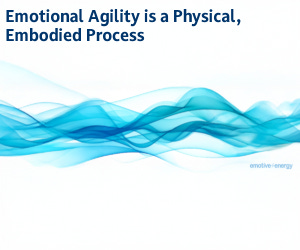Emotional Agility is a Physical, Embodied Process
True emotional agility emerges through the body. Mental strategies help, but they cannot replace direct, physical engagement with emotion as it unfolds.
The term “emotional agility” has gained widespread attention in recent years, especially in business and psychology circles. Harvard professor Dr. Susan David’s book Emotional Agility has become a touchstone, offering a framework for navigating emotions with greater flexibility and resilience. Her approach emphasizes noticing emotional patterns, accepting them without judgment, and choosing responses aligned with personal values. The book offers practical strategies for experiencing emotion, reframing thoughts, shifting mindset, and moving toward intentional action.
The most helpful message of her work is the recognition that emotions should not be avoided or repressed … but rather engaged and experienced. Yet her way of engaging emotions leans heavily on mental strategies and values-based decisions. These top-down tools are helpful, but they do not properly account for how emotional agility is physically lived and expressed through the body.
I use the term emotional granularity to describe the practice of working with emotion at this embodied level. Emotional granularity emphasizes a bottom-up engagement: the process of cultivating sensitivity to the layered, dynamic, lived textures of emotion as they arise physically in the body, moment to moment. This bottom-up engagement provides the essential foundation for real discernment, adaptability, and genuine expression.
The Surge, Swells, and Waves of Emotion
Emotions can come fast. A sharp comment at work or an argument at home can send a surge of affective experience through one’s body instantly. A sharp confrontation, a sudden disappointment, or even an unexpected change in plans can trigger a full-body response. These waves are shaped by one’s body’s intricate systems of electricity, chemicals, movement, muscle and posture.
At the same time, these embodied reactions are present in the ordinary background of daily life. The way a person subtly braces in a business meeting, pauses before speaking … all subtle patterns of self-engagement are physical embodiment.
Our everyday language holds clues to this direct physical experience. Phrases that have endured for generations do so because they capture these real sensations. A few of the clearest idioms include:
Feeling uptight: “Sitting in a routine meeting, a person notices their shoulders creeping upward, the neck stiffening slightly, and the jaw holding firm. Breath narrows into the upper chest, and there’s a low-level tension, a kind of bracing that feels like preparing for a shock, a blow, or an alarm that hasn’t happened yet.”
Getting cold feet: “Just before taking the stage, an actor notices their legs weakening, a dropping sensation in the core of their body. Their face loses expression, the capacity to move. Their sense of themselves draws quickly inward, as if their body is in emergency retreat. There’s a feeling of shrinking, a desire to be small and unnoticed. Extremities go cold.”
Heart pounding: “Preparing in moments to speak up in a room full of people, a person feels their chest tighten and their heart pulse very hard. Each beat is distinct, pounding against the ribs. Breath quickens, and their body seems to hum with alertness, primed for action. Hands tremble slightly, and heat rises through the torso as their face flushes red.”
Getting choked up: “While sharing vulnerable information, a person feels a surge of emotion rise fast through their belly and throat. Their throat tightens reflexively, as if to stop the expression from happening. Breath shortens, and speech falters. The emotion is full and ready to move; one’s body instinctively tightens to hold it back and contain.”
Having butterflies in the stomach: “Waiting for a reply to an important message, a person sits without motion. Feeling a restless, fluttering movement deep in their abdomen, their mind tries to understand this sensation, which stirs more excitation and emerging panic.
These expressions endure because they name something real. The physical embodiments of emotional regulation are always active. They shape experience moment by moment, whether we notice or not.
Cultivating Bottom-Up Emotional Granularity
Emotional granularity develops through sustained, engaged interest in the textures of emotion as they unfold. Placing a dynamic, spacious, very interested attention to felt experience is the key: the subtle tightening in the belly, the shift of breath, the way the legs settle or resist the chair, the proprioceptive shift in speed or angle. This is the real landscape of emotion.
Learning to engage and experience feelings with layered physical precision changes everything.
Most people are familiar with their “loudest” sensations, such as the heat of anger or the chest-tightening of anxiety … but deeper architecture of emotion often goes unnoticed. This intricate physical scaffolding provides the foundation for real emotional agility. When one can sense and engage layered experience, even an intense surge cannot fully hijack attention or overwhelm the mind.
Patterns of bracing, tightening, shrinking, and mobilizing are not just responses, they are emotional regulation. These embodied patterns are how people manage emotional intensity. These enactive responses are mostly unconscious … repeated across years, shaped by habits, family, culture and stress.
Granularity brings emotional patterns into awareness. Not to restrict emotional experience, but to engage and influence oneself more fully. This self-engagement happens in mundane moments: sitting at a desk, walking into a conversation, pausing before replying, etc. Over time, these small acts reshape one’s emotional capacity. One’s body becomes more available to experience, and situational clarity arises naturally from within.
Living in One-Layer: Enactment and Compressed Experience
In heightened emotional states, awareness collapses into the most familiar habits. These are the well-practiced neuromuscular patterns of unconscious action and compulsive thought. Shoulders lift. Breath holds. One’s face hardens. These are a particular body’s clearest cues, perhaps, the personal “somatic markers” of stress or overwhelm.
Consider an even sharper activation—a tragedy, a sudden alarm. Emotion becomes fast, compressed, overwhelming. These mobilizations are immersive and all consuming of attention and action. Experience surges fast and loud … or drops into numbness and disengagement.
This is a one-layer system where all available attention organizes around one dominant (often threatening) signal. Thoughts, sensations, and impulses fuse into the moment. This raw experience produces a patterned response with little room for variation. This works well when speed is needed, but complexity, choice and nuance become lost to impulse. Experience collapses into a repeating pattern, a “repetition compulsion” as early psychoanalysts would describe.
Slowing Down Experience to Feel in Layers
If you can feel experience, you can discern it. If you can discern it, you can influence it. And if you can influence it, you can choose how to meet it.
Slowing down is something most of us avoid at certain times … largely because the experience is very uncomfortable. Many people enact subtle defense patterns to shield themselves from fully sensing what is happening. These patterns are so widespread they could be called a near-universal strategy for avoiding discomfort.
But to feel more is to access more choice. And with that, more life.
In physical terms, this often means a small shift in the way a person compresses themselves under emotional strain. Relaxing even a slight tension, one that unconsciously serves to block affect from overwhelming the mind, can produce substantial change in behavior, outlook and thinking. Emotional granularity begins in these moments: staying close to the physical unfolding of emotion and leaning in, slowly and safely, to ask, what is happening here?
Discernment does not arise from control, but from curiosity. Self-engagement comes from the willingness to remain with sensation a bit longer. And then to allow new responses and meanings to emerge from within one’s body’s natural, unfolding process.
References and Bibliography
David, S. A. (2016). Emotional agility: Get unstuck, embrace change, and thrive in work and life. Penguin Random House.
Fogel, A. (2013). Body sense: The science and practice of embodied self-awareness. W.W. Norton & Company.
Freud, S. (1920). Beyond the pleasure principle (J. Strachey, Trans.). London: Hogarth Press.
Gendlin, E. T. (1981). Focusing. Random House Publishing Group.
International Formative Psychology Institute (IFPI) https://internationalformativepsychology.com
Keleman, S. (1987). Embodying experience: Forming a personal life. Center Press.
Keleman, S. (1989). Emotional anatomy: The structure of experience. Center Press.
Kohut, H. (1971). The analysis of the self: A systematic approach to the psychoanalytic treatment of narcissistic personality disorders. New York: International Universities Press.
Kohut, H. (1977). The restoration of the self. New York: International Universities Press.
Marlock, G., Soth, M., Young, C., & Weiss, H. (Eds.). (2015). Handbook of Body Psychotherapy and Somatic Psychology. North Atlantic Books.
Ogden, P., Minton, K., & Pain, C. (2006). Trauma and the body: A sensorimotor approach to psychotherapy. New York: W. W. Norton & Company.
Peter Wright https://www.embodyingpossible.com
Stanley Keleman https://www.stanleykeleman.com
Read More
The emotive.energy Substack offers posts, notes and podcasts that focus on embodiment theory, practice & application—bridging neuroscience, somatics, psychology and systems thinking for practical use in work and life.
emotive.energy is a research-driven, embodiment-based co-op that consults with leaders, teams and organizations to hone the skills needed in the chaotic modern world. We help people employ and expand their emotional agility, while navigating pitfalls from organizational dysfunction and burnout.
Stephen Buehler, MA, MFT is a psychotherapist, consultant, and crisis response expert with 30+ years of experience across healthcare, mental health, nonprofits, Fortune 500 high-pressure consulting, and creative and sales-driven cultures. As a founding member of emotive.energy, Stephen supports leaders, teams, and organizations in building real emotional agility, responding skillfully to disruption, addressing burnout, and realigning around purpose and authentic shared values. Stephen also hosts the emotive.energy podcast, where dancers, scientists, doctors, clowns, coaches, athletes, and everyday people explore how emotion and impulse shape the way we feel, live, work, and relate.
20,000+ hours of consultation with healthcare leaders, teams and providers on team wellness, collaboration, workplace bullying, community disasters and organizational crisis
20+ years providing psychotherapy to individuals, couples, groups, families; expert in disaster mental health & crisis response
300+ critical incidents and community disasters, leading just-in-time emotional support and follow-up care for affected leaders, doctors, nurses and teams
25+ years of engaged development in embodied, relational, and experiential forms of counseling psychology— with deep focus and passion for Gestalt Psychotherapy, Formative Psychology®, family systems theory, play therapy and psychodynamic thought
Lifelong immersion in athletics, yoga, movement, and somatic practices—including lived experience with degenerative disease and chronic pain—integrating body awareness at both gross and subtle levels











